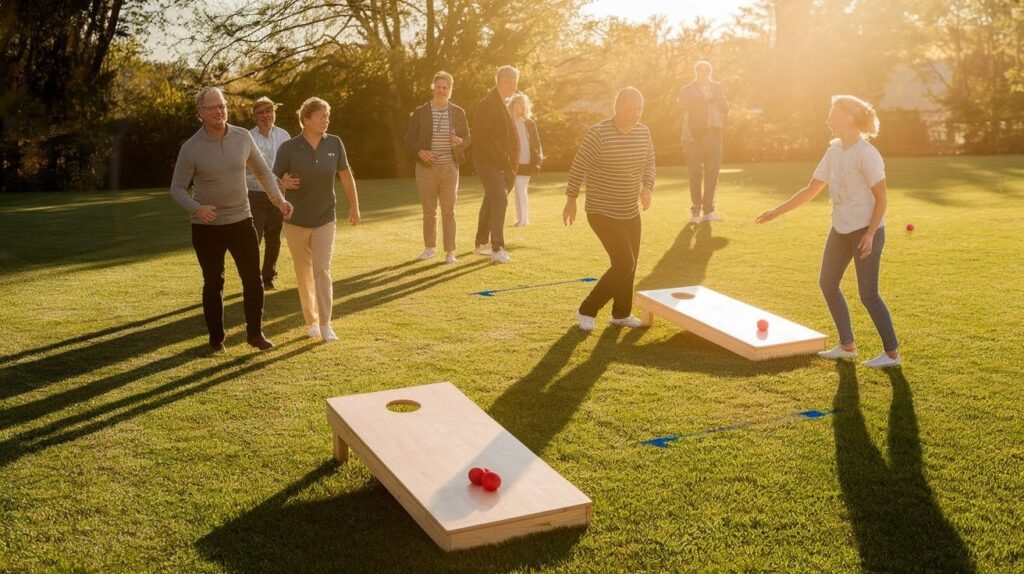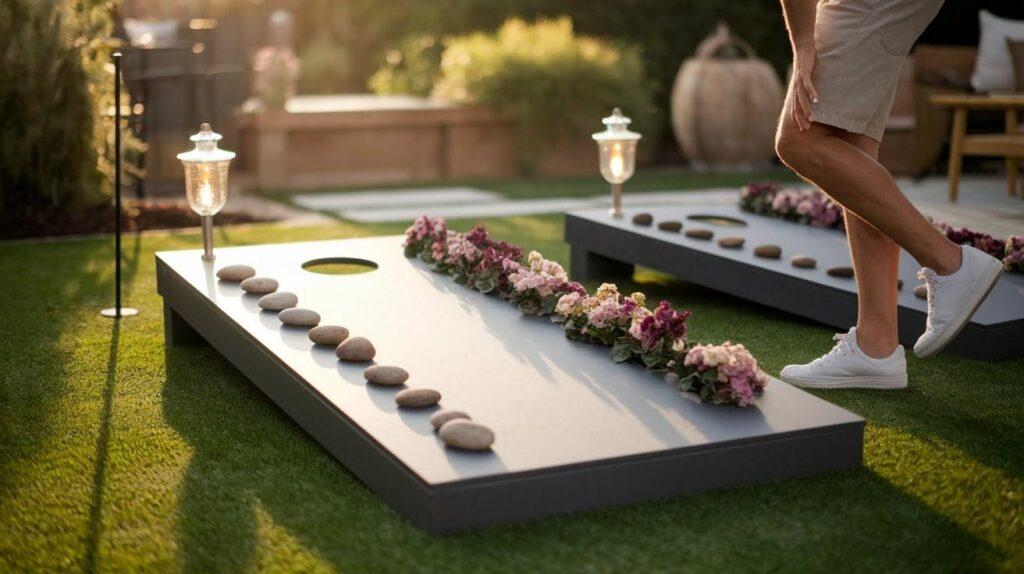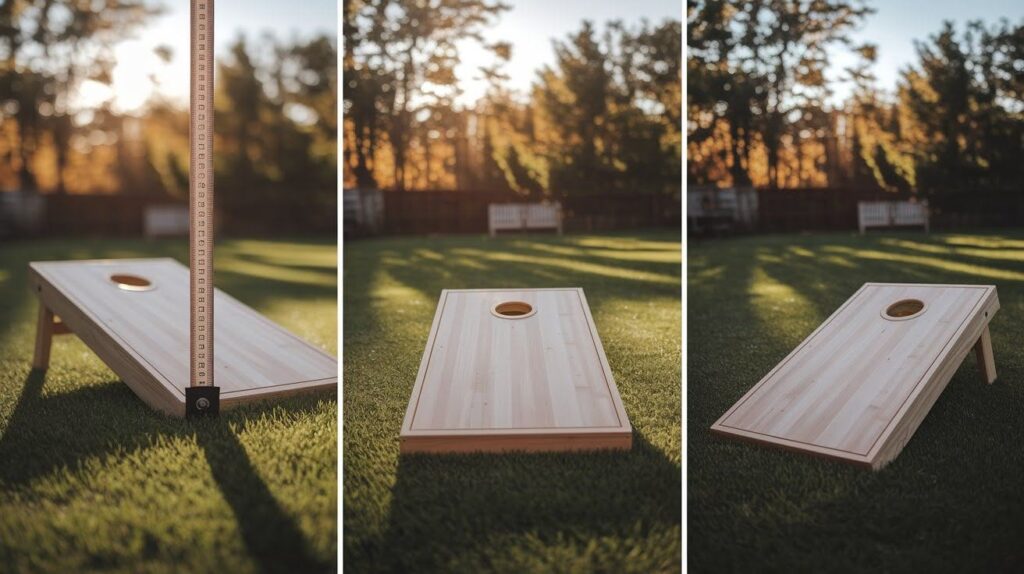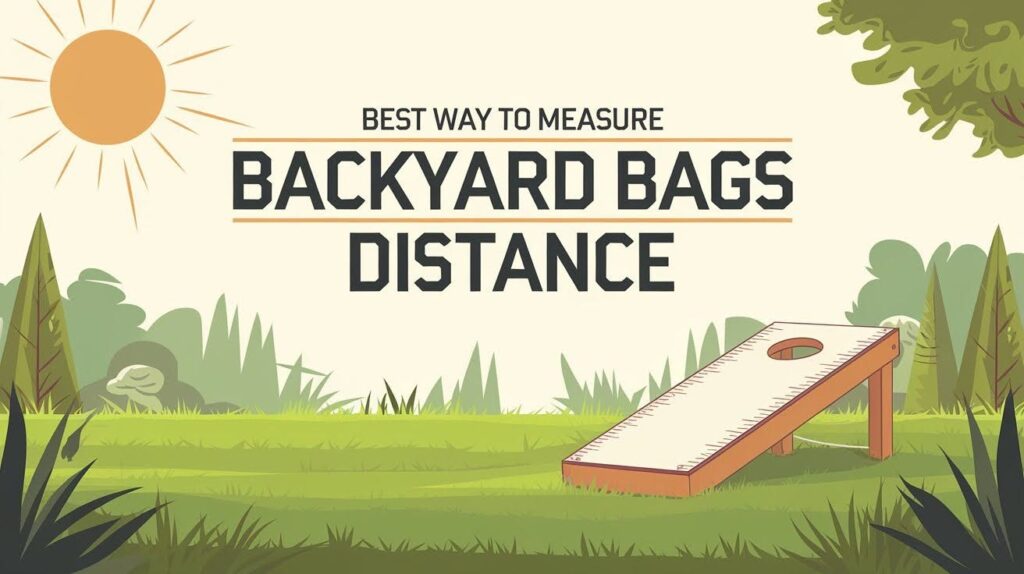I’ve been playing backyard bags for years, and I can’t count how many times I’ve seen friends argue about the proper throwing distance. Sound familiar? You’re probably here because you want to set up your game correctly without all the guesswork.
Here’s what I’ll cover: official tournament measurements, easy ways to mark your distance at home, and why getting this right makes the game more fun for everyone.
I’ve tested different measuring methods and played on dozens of setups. Trust me when I say the right distance makes all the difference between a frustrating game and one where everyone has a blast.
Whether you’re planning a family barbecue or getting serious about your throwing skills, I’ll show you exactly how to measure like a pro. No fancy tools required.
Official Cornhole Board Distance

Getting the distance right isn’t just about following rules, it’s about making sure everyone has fun and plays fair.
Standard Distance for Adults
The official distance is 27 feet measured from the front edge of one board to the front edge of the other board. Both the American Cornhole League (ACL) and American Cornhole Association (ACA) use this exact measurement.
I always tell people this distance matters if you plan to enter tournaments someday. Plus, it gives you the right challenge level. Too close and the game gets boring. Too far and it becomes impossible for most players.
Adjusted Distances for Kids & Seniors
Not everyone needs to throw from 27 feet, and that’s perfectly fine.
For kids under 12, I recommend setting the boards 12 to 15 feet apart. This keeps them engaged without getting frustrated. I’ve seen too many young players give up because the distance was too tough.
The same adjustment works great for seniors or anyone with physical limitations. Just make sure all players agree before you start. The goal is having everyone enjoy the game, not proving who’s the strongest thrower.
How to Measure Cornhole Distance Accurately

I’ve tried every method out there, and these three approaches will get you set up quickly without any headaches.
Tape Measure Method
This is my go-to method for getting it exactly right every single time.
Grab a measuring tape that’s at least 30 feet long. Start at the front edge of your first board and stretch it out to the front edge of the second board. Make sure you’re measuring straight across, not at an angle.
I keep a 35-foot tape in my cornhole bag because shorter ones get frustrating fast. Trust me on this one. The extra length makes positioning so much easier.
Pre-Marked String or Rope Method
This saves tons of time if you play in the same spot regularly.
Cut a piece of rope to exactly 27 feet and mark both ends clearly. I use colored tape so I can spot the marks quickly. Now you just lay it down between your boards and you’re ready to play.
The best part? No math, no measuring, no fuss. Just grab your rope and go.
Yardstick or Ruler Method (for Short Distances)
Perfect for indoor games or when playing with kids.
A yardstick works fine for shorter distances like 12 or 15 feet. You might need to measure it in sections, but it gets the job done. I only use this method for junior setups since most yardsticks are only 3 feet long.
Quick Setup Hacks for Backyard Play

Sometimes you need to get your game going fast without dragging out measuring tools every single time.
Using Permanent Markers in Your Yard
Smart players mark their spots once and forget about measuring forever.
I hammer small metal stakes into the ground at exactly 27 feet apart. You can also use spray paint on concrete or place painted pavers as markers. The key is making them visible enough for you but not so obvious that your neighbors think you’re crazy.
Some folks use decorative stones or even plant small flowers at the right spots. Gets the job done and looks intentional. My buddy uses two matching garden lights, which looks pretty cool at night.
Pacing It Out Without Tools
This trick has saved me countless times when I forgot my measuring tape.
First, figure out your stride length. Mine is almost exactly 3 feet, so I need 9 steps to get 27 feet. Measure your normal walking pace once at home, then you’ll always know.
Walk heel to toe for more accuracy. Count your steps carefully and don’t rush it. I’ve gotten within a foot of perfect using this method, which is plenty good for casual games. Your friends will think you’re some kind of cornhole wizard.
Common Mistakes When Measuring Cornhole Distance

I’ve watched people mess up their setup in the same ways over and over, and it always ruins the game experience.
Measuring Hole-to-Hole Instead of Front-to-Front
This mistake makes your throwing distance about 3 feet shorter than it should be.
I see this all the time at backyard parties. People think the hole is the important part, so they measure from hole to hole. But official rules clearly state front edge to front edge of the boards.
When you measure hole to hole, you’re only getting about 24 feet instead of 27. That might not sound like much, but it makes the game way too easy. Your throwing skills won’t improve, and you’ll struggle if you ever play on a properly set up court.
Not Leveling the Ground First
Slopes and bumps throw off your distance measurement more than you’d think.
I learned this the hard way when I set up on a sloped yard. Even a small hill can make your 27-foot measurement actually shorter or longer depending on the angle. The bags roll weird, and throws that should be perfect end up way off target.
Always check that both boards sit level before you start measuring. If your yard has a slope, find the flattest spot you can. Your game will be so much better when everything sits right.
Balancing Accuracy & Fun

The secret to great cornhole is knowing when to be strict about rules and when to just let everyone have a good time.
When to Stick to Official Measurements
Some situations call for playing by the book, no exceptions.
If you’re in a tournament or league play, stick to 27 feet exactly. Period. I’ve seen people get disqualified for measurement issues, and it’s never pretty. When money or trophies are on the line, every inch matters.
Also keep it official when you’re practicing for competitive play. You won’t get better at tournament-level throwing if you always play at shorter distances. And when your buddies start talking trash about who’s the real cornhole champion, official measurements settle the debate once and for all.
When It’s Okay to Adjust
Most backyard games should prioritize fun over following every single rule.
At family barbecues or casual parties, adjust the distance so everyone can actually make some shots. Kids get frustrated and quit if it’s too hard. Grandparents might not be able to throw 27 feet comfortably.
I also adjust when space is limited. My friend’s tiny backyard only allows about 20 feet. We could skip playing entirely, or we could adapt and still have fun. Guess which option we choose? The bags still fly, people still laugh, and everyone goes home happy.
Quick Tips
Measuring Basics
- Always measure front edge to front edge, never hole to hole
- Use a 30+ foot measuring tape for best accuracy
- Level your ground before measuring distance
Setup Shortcuts
- Mark permanent spots in your yard with stakes or painted stones
- Learn your stride length for quick pacing (mine is 3 feet per step)
- Pre-cut a 27-foot rope for instant setup
Distance Guidelines
- Adults: 27 feet (official tournament standard)
- Kids under 12: 12-15 feet works great
- Seniors: Same shorter distance if everyone agrees
When to Bend the Rules
- Stick to 27 feet for tournaments and serious competition
- Adjust shorter for backyard parties and family games
- Prioritize fun over perfect measurements at casual events
Common Fixes
- Check that both boards sit level before starting
- Find the flattest area of your yard
- Don’t rush when pacing out distance
Conclusion
Getting your cornhole distance right doesn’t have to be complicated. Whether you use a measuring tape, pre-marked rope, or just pace it out, the key is being consistent and fair to all players.
Remember that 27 feet is the gold standard for adults, but don’t be afraid to adjust for kids, seniors, or casual backyard fun. The goal is making sure everyone enjoys the game.
I’ve seen too many great games ruined by poor setup. Take those extra few minutes to measure correctly, level your boards, and mark your spots. Your friends will thank you, and you’ll all play better because of it.
Now grab your bags and get out there. You’ve got the knowledge to set up like a pro every single time.
Frequently Asked Questions
What is the official cornhole distance for adults?
The official distance is 27 feet measured from the front edge of one board to the front edge of the other. Both the American Cornhole League (ACL) and American Cornhole Association (ACA) use this standard measurement.
Can I adjust the distance for kids or seniors?
Yes, absolutely. I recommend 12 to 15 feet for children under 12 and the same shorter distance for seniors or anyone with physical limitations. Just make sure all players agree before starting the game.
What’s the easiest way to measure without tools?
Learn your stride length and pace it out. My normal walking pace is about 3 feet per step, so I need 9 steps to get 27 feet. Measure your stride once at home and you’ll always be ready to set up quickly.
Should I measure from hole to hole or board edge to board edge?
Always measure from front edge to front edge of the boards. Measuring hole to hole gives you about 24 feet instead of the proper 27 feet. This makes the game too easy and won’t help you improve your skills.
How do I mark permanent spots in my yard?
Use small metal stakes, painted pavers, or decorative stones placed exactly 27 feet apart. Some people use garden lights or even plant flowers at the right spots. Pick something visible but not too obvious to your neighbors.

